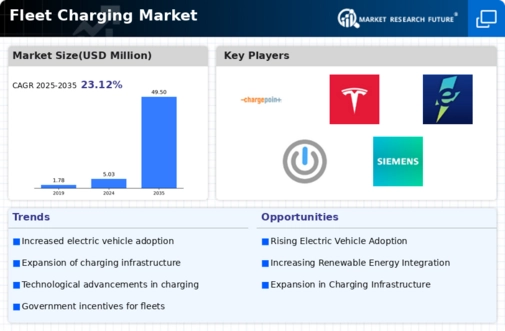Market Growth Projections
The Global Fleet Charging Market Industry is poised for substantial growth, with projections indicating a market size of 5.03 USD Billion in 2024 and a remarkable increase to 49.5 USD Billion by 2035. This growth trajectory suggests a compound annual growth rate (CAGR) of 23.12% from 2025 to 2035. Such figures highlight the increasing investment in electric vehicle infrastructure and the rising demand for efficient charging solutions. The market's expansion is likely to be driven by a combination of technological advancements, government policies, and the growing emphasis on sustainability among corporate fleets.
Government Incentives and Policies
Government initiatives play a crucial role in shaping the Global Fleet Charging Market Industry. Many countries are offering financial incentives, tax breaks, and subsidies to encourage the adoption of EVs and the development of charging infrastructure. These policies not only stimulate demand for electric fleets but also foster investment in charging technologies. For instance, various regions are establishing ambitious targets for EV adoption, which directly influences fleet operators to transition to electric solutions. As a result, the market is likely to experience robust growth, with a projected CAGR of 23.12% from 2025 to 2035, indicating a strong policy-driven momentum.
Rising Demand for Electric Vehicles
The increasing adoption of electric vehicles (EVs) is a primary driver for the Global Fleet Charging Market Industry. As governments worldwide implement stricter emissions regulations, the shift towards EVs accelerates. In 2024, the market is projected to reach 5.03 USD Billion, reflecting the growing need for efficient charging solutions. Fleet operators are increasingly investing in EVs to reduce operational costs and meet sustainability goals. This trend is expected to continue, with projections indicating that by 2035, the market could expand to 49.5 USD Billion, driven by the rising number of EVs in commercial fleets.
Corporate Sustainability Initiatives
Corporate sustainability initiatives are increasingly influencing the Global Fleet Charging Market Industry. Many companies are adopting green practices to enhance their corporate image and meet stakeholder expectations. Transitioning to electric fleets is a key component of these sustainability strategies, as it helps reduce carbon footprints and operational costs. As organizations commit to sustainability goals, the demand for fleet charging solutions is expected to rise. This trend is further supported by the growing consumer preference for environmentally responsible companies, which may drive fleet operators to invest in electric vehicles and the necessary charging infrastructure.
Expansion of Charging Infrastructure
The expansion of charging infrastructure is a vital driver for the Global Fleet Charging Market Industry. As the number of electric vehicles increases, the need for accessible and reliable charging stations becomes paramount. Governments and private entities are investing in the development of charging networks to support the growing demand. This expansion not only facilitates the adoption of electric fleets but also alleviates range anxiety among fleet operators. The availability of charging stations in strategic locations enhances operational efficiency and encourages more businesses to transition to electric vehicles, thereby propelling market growth.
Technological Advancements in Charging Solutions
Technological innovations are significantly impacting the Global Fleet Charging Market Industry. The development of fast-charging technologies and smart charging solutions enhances the efficiency and convenience of charging electric fleets. Innovations such as wireless charging and vehicle-to-grid technology are emerging, allowing for more flexible and efficient energy management. These advancements not only reduce downtime for fleet vehicles but also optimize energy consumption. As the market evolves, the integration of advanced technologies is likely to attract more fleet operators, thereby contributing to the overall growth of the industry in the coming years.

















Leave a Comment